#deshret lore
Explore tagged Tumblr posts
Text
Reblogging this because these are all valuable additions to the criminal rap sheet the conversation, but especially these tags:
#on another note#i like to think Mehrak's core is the same as the primal mechanisms and Kaveh has his own Benben situation going on#and if we stretch the possibilities a little bit more then maybe Mehrak is a sealed Jinn that chose Kaveh as its master#(any visual similarities to Deshret and possible character foil shenanigans aside)#my point is: sumeru will pull an icarus eventually and plummet is all because of their endless curiosity#nerds. all of them (affectionate)
I wholeheartedly agree and definitely think that the game going out of its way to state that Kaveh used a machine core from Deshret's era basically confirms that Mehrak is (at the very least) equivalent to Benben, the core of a primal construct. I'm also inclined to agree that the primal constructs may have been, perhaps in later iterations, in-dwelt by Jinn convinced to serve Deshret, making it seem very likely to me that Mehrak could be a Jinni or Jinn remnant. This would make the name "Mehrak" ("little light") particularly symbolic, as the Jinn were said to be born of the light of the moon on the water lilies that sprung from Nabu Malikata's blood.
(Ironically, if Mehrak was a Jinni, that would at least save Kaveh from the law, as a Jinni is... technically not a "machine lifeform." Right? Right. lol)
However, even if the primal constructs have nothing to do with the Jinn, the game does hint several times that the machines were constructed through the use of forbidden knowledge:

So like, not only does Mehrak violate the "no machine lifeform" rule, it also violates the most dangerous core taboo of Sumeru's entire civilization.
One day Mehrak is going to beep-boop its way into starting Apocalypse 2: Forbidden Knowledge Boogaloo and Alhaitham, Cyno, and everyone else who helped Kaveh's and Tighnari's (accidental) sins against humanity fly under the radar are really going to be rethinking their life decisions.
It's okay though, it will be a cute apocalypse and everyone will forgive Mehrak and Karkata right away.
I think one of the funniest things about the Sabzeruz event is that the devs choose to go with Candace, Traveler, and Paimon having a whole "Ooh, two mysterious men are going into an alley to have a 'private' conversation; they must be bad guys!" only to then go "Oh just kidding, it was only Alhaitham and Kaveh doing typical Alhaitham and Kaveh things."
Except the "Alhaitham and Kaveh" thing in question this time was talking about Mehrak, a sentient robot that Kaveh built using absolutely forbidden technology, and which he then whole-heartedly willed would develop a consciousness of its own, violating one of the central taboos of his nation's governing agency, committing what amounts to an inherent and extreme felony punishable by law.
Alhaitham and Kaveh: Listen, we're not bad guys discussing illegal activity here. We're just two men having a private, personal conversation. Happens all the time.
Paimon, Candace, and Traveler: Oh cool, they're not doing a crime; they're just gay.
But they were, in fact, doing a crime.
3K notes
·
View notes
Text
I am just a poor girl standing in front of the hkvthm fandom begging them to realise that it's KAVEH who is Deshret and not ALHAITHAM // gets shot
But good grief alhaitham deshret is the funniest fucking thing to exist because my man is most representative of the present Order of the Akademiya


Meanwhile Kaveh's namecard

nahida's own true wisdom boy is KAVEH he is DESHRET he is KHAENRIAH HE IS THE ARROGATION OF MANKIND
So WRITE THE DESHRET KAVEH FICS AS GOD INTENDED BECAUSE ALHAITHAM IS LITERALLY ANTI DESHRET
#genshin impact#kaveh#alhaitham#king deshret#motifs#khaenriah#genshin lore#haikavetham#haikaveh#kavetham#lore#every time i see deshret haitham i lose a brain cell
267 notes
·
View notes
Text
NONE OF YOU TOLD ME OCHKAN WAS SUCH A RAGING FUCKING HOMOSEXUAL
#he wants xbalanque BADDDDDDD#like dude chill we get it you've got it down abysmal for that guy#“my god my universe” ahh 😭😭😭#men being just a little unsalvageably obsessed is my favorite animal#deshret boethius rene jakob it's all the same#why do they shove the high quality yaoi in the world quests#ochkanatlan#och kan#xbalanque#natlan lore#genshin lore
36 notes
·
View notes
Text
Something about how the Seelie were cursed to lose everything if they fell in love. Something about how King Deshret Loved Nabu so much he allowed forbidden knowledge to corrupt him. Something about how Rukka knew that Deshret loved her. Something about how Nabu ignored him, despite the fact she knew he loved her and it was part of her plan. Was Nabu scared that she would lose her form? Did she fully stop feeling love because she was horrified at what happened to her kin? Hi, I'm Reverie, and in this essay-
#nabu malikata#greater lord rukkhadevata#king deshret#they make me sick#Hoyo drop more Seelie lore and my life is yours#Natlan please#Natlan give us Seelie lore
78 notes
·
View notes
Text



you know you have yourself a peak lore character when they start being referred to as "God King"
#deshret#remus#decarabian#tagging them first in case u dont recognize them#the big five of genshin lore with nabu malikata (shes a god king too iirc) and och-kan#theres others too too sure but these five... theyre so good so tragic so messed so delicious...#team xbalanque is something else it's like they tailor made it to cater to me and my preferences specifically#genshin impact#i yapped
13 notes
·
View notes
Text
Spoilers for Ochkanatlan Quest!!
I haven't researched too deep into this topic, but I will go off of what was said to us directly in the Ochkanatlan World Quest.
So, the part about some humans evolving from dragons...
My focus is on Tighnari. His race to be more specific.

This is what the Tighnaris were originally supposed to be like. They were huge dessert dogs. Hermanubis was a Tighnari.
But after what happened happened, they moved to live in the forest. And centuries after, they slowly evolved to suit their new home.
So could it be possible that the Tighnaris were originally dragons? First they changed form to suit Deshret's civilization. As the age of humans came, they shifted form again to be human like.
Humans cannot evolve, only dragons can.

Ok this guy is a dragon. Silly theory.
#if hermanubis was a dragon sage of king deshret#oooo can you imagine#anyway he is my favourite sage of deshret he is so smart#also what implications this puts#like are all the animals who evolved to become human like dragons#diona is a dragon everybody#plot twist of 5.0#genshin impact theory#genshin impact lore#genshin lore#genshin theory#genshin tighnari#tighnari#hermanubis#genshin#genshin impact
22 notes
·
View notes
Text
Other gods during the archon war: this land isn’t big enough for the two of us…we will fight to the death and only the strongest god will assume a seat in Celestia and rule this land…
Rukkhadevata texting the Sumeru deities group chat in the way you’d text your roommates about chore division: oh yeah btw king deshret me & the goddess of flowers r meeting up w the International Teyvat Immortal Yuri Polycule on wednesday do u wanna come
#fern.txt#genshin#wearing a shirt that says ask me about my lore about the international teyvat yuri polycule#rukkhadevata#king deshret#deshret is invited to the yuri polycule on Wednesdays in the same way zhongli qualifies as part of the liyue adeptus sector of the#international yuri polycule on Saturdays#guys I have all my focus intensive STEM classes today iiim so tired ❤️ lesbian rights
379 notes
·
View notes
Text
One of my biggest hyperfixations nowadays is the lore of ancient kingdoms in Genshin Impact. I wanna know what they were all about, how life was like for them, what led to their downfalls, and how or if they interacted with one another. It’s said that there used to be a unified civilization of humans in Teyvat, and that’s why so many ruins have similar architectural details despite being spread across all the nations of modern Teyvat. We still have very little lore about the Nameless Ruins in the Chasm, we still don’t even have a name for them despite Dainsleif’s quest taking place there. But there’s also strange similarities between the stories of the ancient kings and how the kingdoms fell. I already buy into the theory that King Deshret of Sumeru/Gurabad may be related to or the same as King Irmin of Khaenri’ah, since the Traveler’s twin is the Abyss Prince/Princess, and the Traveler seems to remind Liloupar of Deshret in terms of looks and powers. And wouldn’t it be fitting for Deshret, who turned down the Gnosis and challenged the heavens by obtaining Forbidden Knowledge (abyssal power) to be in some way related to the king of Khaenri’ah, a nation without a god that hid from Celestia and was later punished for it? And there’s sources about Remus, the king of Remuria, citing Remus as a god king just like Deshret. And Remuria as well as Remus were swallowed by the Abyss, reminding me of the sinking of Enkanomiya, where the names of the people are lifted directly from Greek/Roman mythology. And Remus is directly inspired by the Rome founding myth, while Remuria as a whole is inspired by ancient Rome. And the most tantalizing thing for me has to be the lost kingdom of Sal Vindagnyr, where it seems so cut off from these other lost kingdoms but their princess dreamt of events that wouldn’t come to pass for thousands of years, long after her civilization was destroyed. She was born under an offshoot of Irminsul, and had the power of prophecy through her connection to the tree. She foresaw the Cataclysm in Khaenri’ah, the coming of the abyssal dragon Durin, but she had no frame of reference for when these visions would come to pass. Think about what that would do to you as your kingdom was being swallowed in ice and snow, the gods having forsaken you, and your father asks to see a vision of the snow cleared and blue skies, but you’ve already forgotten what that looks like since it’s been so long in the blizzard. Dragonspine and the ruins of Sal Vindagnyr haunt me.
EDIT: I think I figured something out about Dragonspine. In every source I could find on the topic, people usually sort the Princess’s vision of Durin before the Celestial Nail that destroyed their Irminsul tree. I think, since the people of Sal Vindagnyr proclaimed to be in such close contact with Celestia, that Celestia dropped the nail on Dragonspine as a response to the princess’s vision. They laid down a preemptive strike against the abyss and then realized, “oh shoot, we messed up,” because Durin wouldn’t appear in Mondstadt until thousands of years later! So Celestia gets the heck out of dodge before the humans can seek retribution for the destruction of their home, that’s why they abandoned the people of Sal Vindagnyr. The humans were left wondering what they did wrong, but Celestia is the one at fault! Celestia panicked and messed up!
#genshin impact#Dragonspine#Remuria#Gurabad#Sal Vindagnyr#the chasm#Mondstadt#Liyue#Inazuma#enkanomiya#Sumeru#Fontaine#king Deshret#king Irmin#king Remus#khaenri'ah#Genshin impact lore#lore#theories
106 notes
·
View notes
Text
thinking of king deshret and nabu malikata again
#he loved her so much#and she knew it and considered him foolish#she died for him amd his quest to break the cycle of the 7#he went mad after her death#oh they make me illlllll#genshin impact#genshin lore#king deshret#nabu malikata
9 notes
·
View notes
Text
[3.8] Technology as a False God: On "Evolution," the Duality of Machines, Replication, and Wisdom
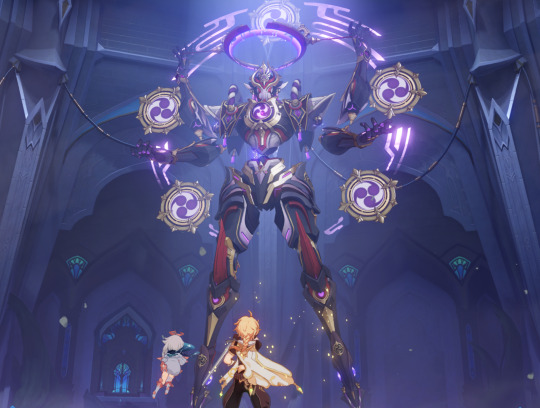
“To recognize untruth as a condition of life: that is certainly to impugn the traditional ideas of value in a dangerous manner, and a philosophy which ventures to do so, has thereby alone placed itself beyond good and evil.” –Friedrich Nietzsche, Beyond Good and Evil
Before we move on to the nation of justice, I want to do one last inquiry into the narrative significance of machines and technology in Genshin’s 3.x patch cycle. Here, I’ll discuss how divinity (or “godhood”) and technology are treated as interchangeable tools to surpass fate and the boundaries of mortality, the potential problems with treating them this way, and propose an alternative relationship between humanity and technology as illustrated through Karkata, Benben, Tamimi, and Mehrak. By foregrounding machines, we learn something intriguing about ourselves and the “truth” of this world as we perceive it.
SPOILERS: All Sumeru Archon Quests, Caribert, the Golden Slumber and one out-of-context screenshot from Dual Evidence, the Dirge of Bilqis and its post-quests, Khvarena of Good and Evil, Nahida’s second Story Quest, Faruzan’s hangout, an out-of-context screenshot from Baizhu’s Story Quest, and major spoilers for Persona 5 strikers at the end. Also some dialogue from Shadows Amidst Snowstorms and A Parade of Providence, two limited-time events from 2.3 and 3.6 respectively.
Disclaimer: I have tried my best to write this post so that it stands on its own, but because it is still a sequel it will probably make the most sense with the context of part 1. Here are the previous posts leading up to this one:
Part 0: On Dreams, the Abyss, Forbidden Knowledge, and Wish Fulfillment
Part 1: The Uncanny, Fate and the Machine
Terminology: Machine is sometimes used interchangeably with “technology” in this post.
Technology or tool here is referring to technologies specifically used to pursue a wish like immortality in the face of existential dread, not the use of technology or medicine (which I do not address here, and is very difficult to separate from the former) to facilitate someone’s life who could otherwise not survive without that technology, or would have a more painful lived experience without it.
Also, though I don’t engage directly with “A Cyborg Manifesto” here, Donna Haraway’s ideas have greatly influenced my own over the years since I read her in college (although I mostly disagree with her on many points, or at least don’t go as far in boundary deconstruction as she does). I owe my interest in technology studies to her and that piece. Her essay is linked here and at the bottom if you would like to read it.
(and finally with many, many, many thanks to my boyfriend for multiple beta reads despite not having played a single Hoyoverse game, helping me work out the philosophy bits and contextualizing them in history, and encouraging me to finish this)
TL;DR: Machines are friends, not food!
No Matter the Cost
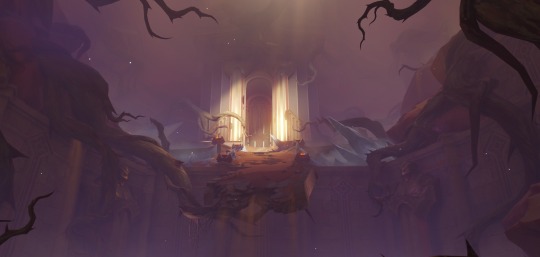
“...Perhaps it is as the notebook says, and we can find a power that transcends even that of the Abyss — the power of ‘evolution’...” -Records of Unknown Attribution (I) “Life, death... and the world around us all follow a set of laws... Hehe, but if you never test the limits, how can anyone know where the boundaries of these laws are?” -Baizhu Voicelines, Chat: Natural Laws “...Even the ominous thing that came down from the heavens shall be ours to use…” -Hyglacg, Shadowy Husk in the Chasm
Without a doubt, the star of this patch cycle is Khaenri’ah, which lurked in subtext and allegory in the Archon Quest, haunted Sumeru’s landscape with its massive defunct Ruin Golems, and finally smacked us in the face with its physical location in Khvarena of Good and Evil..
We already know that Khaenri’ah was a nation that put its faith not in the gods but rather in human ingenuity and technology, and that they ultimately attained a power so great that they “almost touched the dome of the firmament.” They did this by researching increasingly dangerous energy sources for their numerous mechanical creations, the Ruin Machines we are all too familiar with by now. They started out with Azosite, a Ley Line-based elemental energy source that powered their earliest Ruin Guard models, like those scattered around Devantaka Mountain.

Nasejuna: This giant furnace is used to make a substance known as Azosite. It is the core of this entire factory, and the Energy Blocks we saw earlier were derived from this place.
But this energy source proved inefficient and therefore inadequate for Khaenri’ah’s goals, which led them to seek a higher power from beyond the skies that could fuel their larger machines with perpetual energy. This likely is the bridge between Khaenri’ah’s fate and Chlothar’s mysterious remarks in Caribert about the Abyss Sibling:
Chlothar: We once believed that you would bring new strength and hope to Khaenri'ah. Chlothar: To us, you were the Abyss... A wondrous mystery far beyond our imagination and comprehension... Chlothar: ...And the one who controls the Abyss can control everything! Chlothar: We yearned for that future. We looked to you to take us there. Chlothar: But what did you bring us instead?
Though Khaenri’ah presents itself proudly as a godless nation, it may have been founded around the time when the celestial nails dropped in Teyvat’s first forbidden knowledge pollution event, which destroyed the unified human civilization. As potential survivors of this devastating act by the Primordial One, Khaenri’ahns then settled in a lifeless land without plants or animals of its own, and they hoped to build something there that belonged solely to humanity. The Heavenly Principles had turned on the world’s earliest humans, and they were powerless against them. Chlothar’s words betray the scars of this trauma on Khaenri’ah, as well as their desperation to control their fate by looking to the Abyss.
As a brief refresher from the previous part, we discussed how the German word heimlich denotes “the home,” all that is familiar and known, while unheimlich (uncanny) refers to all that is unfamiliar and external to the home, such as the wilderness. The Abyss sibling and the Traveler are external variables to Teyvat, making them otherworldly, unfamiliar entities full of potential to surpass Teyvat’s natural laws. Although the Abyss sibling is not a god per se, they were probably as close to a god as Khaenri’ah ever had, because to them the sibling embodied the higher power they were searching for, and they saw that “godliness,” a sort of functional divinity, was yet another technology for them to master. In this way, the Abyss sibling (and their functional divinity) was a powerful tool for Khaenri’ah’s desired end, the “future they yearned for,” a being who could deliver them to the end of their suffering under the Heavenly Principles.
It’s similar to what King Deshret represented to Rahman and the radicals in Archon Quest. The hopelessness of Sumeru’s situation before the Archon Quest’s conclusion is an allegory for the position humanity finds itself in under the rule of the Heavenly Principles, with the Akademiya symbolizing Celestia and the desert dwellers symbolizing Khaenri’ah. The material consequences of the Akademiya’s rule on their lives created a dangerous situation for the desert, and those most desperate to change their fate were willing to believe in the impossible:
Dehya: …The rougher life gets, the more they wanna believe in King Deshret. Way they see it, King Deshret’s resurrection is their only chance at overthrowing the Akademiya. … Dehya: Sumeru is run by wise and mighty sages. To them, us desert dwellers are nothing but tools that can be used and discarded at their whim. Dehya: We’re cheap labor. Like livestock, but easier to control…Nothing more. …
Rahman: We’ve waited a long time for this day to come… The sun and the moon no longer shine here. All you see now is cracks in this desiccated land. But, fate has finally dealt me a hand to play against the Akademiya.
Rahman: With these scholars in our custody, we’ll stomp the Akademiya’s forces and fight our way beyond the Wall of Samiel.
Like the Abyss sibling, Deshret’s divinity is both a nebulous symbol of hope and also the means to an end, a tool or “technology” for surpassing fate.
Celestia is untouchable, unconcerned with mortal lives, and the boundaries that govern humanity leave no room for them to negotiate their rule:
"Resolve, valor, love, hate...they will all twist in the river of time. But the 'rules' will never change." –Magatsu Mitake Narukami no Mikoto, Living Beings
Instead of bowing to Teyvat’s laws, Khaenri’ah pushed them to their limits. The cost of their failure spelled the end of their nation as they knew it, polluting Khaenri’ah and Teyvat with forbidden knowledge again.
And speaking of forbidden knowledge pollution, let’s talk about Apep’s role in Nahida’s second story quest, because if all that wasn’t enough, the metaphor becomes quite literal in Apep’s case. Nahida’s second story quest is many things, all of which will be extremely important in Fontaine when we deal more directly with the idea of forms, the Self, and mirror images, but its most useful application to both Sumeru’s story and the overarching main story is the allegory of Apep swallowing Deshret.
In exchange for allowing him to establish his kingdom in the desert, Deshret promised to pass all of the knowledge he learned to Apep once he died. When that day did come, Apep literally ate Deshret’s body in order to assimilate his knowledge (or memories) into its body. Little did Apep know, this was all Just As Deshret Planned, and its body became a containment zone for the lethal forbidden knowledge he accumulated after the Goddess of Flowers’ death.
Apep’s goal was, and still is, to overthrow the Heavenly Principles that took Teyvat from it and the other Sovereign dragons, and using Deshret’s knowledge was yet another stepping stone to achieving this goal. Seems a little similar to Khaenri’ah, right? It’s even in the title of its boss music: ��God-Devouring Mania.” This idea of not just utilizing divinity as a tool, but also metaphorically consuming it as an energy source, like a predator would consume its prey, is crucial to understanding its purpose as an aid in a larger project of “evolution.” (Edit: in other words, it’s all about power).
Drink Not That Bitter Salt Water
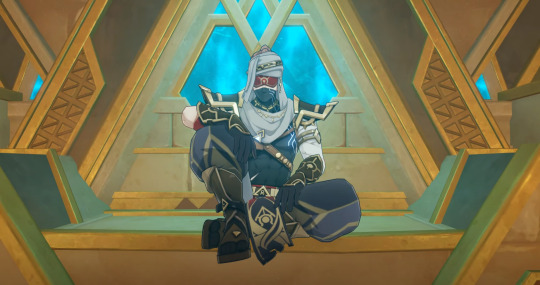
“Flesh decays, and with it decay all martial arts mastery and all poignant memories. Perhaps only by converting one’s four limbs and body into sturdy mechanical parts, and by at last sacrificing one’s very own heart for a sophisticated mechanical one, can one transcend the impermanence of the fleshly form…” -Marionette Core Item Description “A reptile that has mutated after feeding from greater lifeforms. Majestic beasts are sometimes revered by human beings as the embodiment of a greater power, their visages turned to analogy to feed in reference to a person, feeding their ego. However, the majority of beasts that have absorbed the "greater power" were slain by the overwhelming nature of the power itself. Only a few among their number evolved new forms.” -Consecrated Horned Crocodile, Living Beings Video still from WoW Quests
As it turns out, the relationship between divinity and technology to humanity is not just unidirectional, but interchangeable. Let me show you what I mean.
In the Golden Slumber world quest, the Traveler wanders through the ruins of King Deshret’s civilization in search of a novel area of research for Tirzad’s paper with Jebrael and Jeht, two members of Tirzad’s hired investigation team. In the depths of King Deshret’s mausoleum, they stumble upon Samail, who is collaborating with the Fatui to locate King Deshret’s secret, the Golden Slumber.
At the conclusion, Jebrael and Samail actually reach that “place” after arriving at Deshret’s throne in Khaj-Nisut. In order to save Jeht, Tirzad, and the Traveler from the encroaching Golden Dream, Jebrael joins Samail in the sea of consciousness:
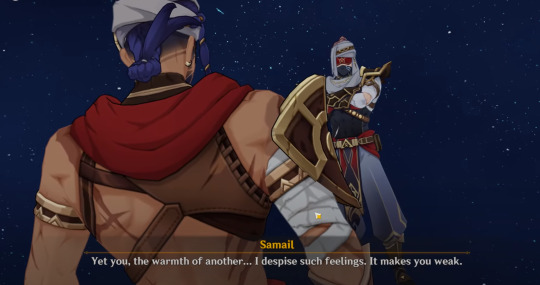
Jebrael: I'm inside... the Golden Slumber promised by Al-Ahmar? Samail: Oh... You are not "us" yet. Samail: ...It's fine. Soon, there'll be no "you." "You" will become a part of "us." This meaningless talk will be unnecessary then. … Samail: You should obey. Al-Ahmar's will is our will. The Thutmose's dreams are our dreams. Jebrael: No! Ufairah taught me that I'm not just some part of you, I'm an independent person! I have my own dreams... I won't go back! Samail: Jebrael, why don't you understand? Love is just a fever. I even eliminated the infection for you. Has the heat made you lose your mind? Jebrael: You're the one who's lost their mind, Samail, not me. The Golden Slumber that Al-Ahmar promised us isn't like this... It's not a sad place with only "we" and no "I." Samail: I'm not sad. I know what I want. My dream is to be one with the Thutmose. Samail: Yet you, the warmth of another... I despise such feelings. It makes you weak. Video still from WoW Quests
When they worked under Babel, Jebrael saved Samail from an assassin Babel sent in their exploration of Gurabad. Classified as traitors of the Tanit, Samail and Jebrael then founded the Thutmose Eremite faction together and were the only meaningful connection each other had until their first attempt to uncover Deshret’s secrets. On this expedition, Jebrael met Ufairah and had their daughter Jeht together, further pulling him away from the Thutmose and from Samail. Samail then kills Ufairah in one final attempt to make Jebrael stay, but even this is not enough, and Samail fails to “possess” him in the end.
Samail’s loneliness and despair then drove him further toward the Golden Slumber of his dreams, where he would never truly be alone again. He resents Jebrael’s attachments to the material world and likens them to an illness because these attachments are what make him an individual and prevent him from returning “home.”
It doesn’t really matter to Samail what King Deshret’s original intent for the Golden Slumber was, because he needed to appropriate the project for his own subconscious wish, his own intent to transcend his flesh and become “one” with his departed god’s dream, indeed to merge with Deshret himself. If rationalizing this wish required confounding it with Deshret’s, so be it. With the Golden Slumber’s technology, he could consume everyone and everything.
Rahman and the radicals relied on both the technology that (falsely) promised Deshret’s resurrection and Deshret himself to deliver them a brighter future, but here Deshret and his technology are more difficult to separate from one another. His divinity is technology in this sense, and using that technology allowed Samail to surpass the boundaries normally imposed on mortals. Though his and Jebrael’s bodies died in the material world, their consciousness is now infinite in the Golden Slumber.
Babel’s motives in the Dirge of Bilqis were also quite similar to Samail’s. After opening the path to the Eternal Oasis, her true intentions to monopolize the oasis and overthrow the Akademiya came to the surface:
Babel: Whether she is alive or dead, whether she can or cannot be resurrected... As long as the Eternal Oasis is under my control, all such things will be mine to decide. Babel: I shall be the sole Prophetess of the slumbering goddess, the Tanit's law shall be divine edict, and the prosperity of the Tanit shall be the pre-ordinance of her divine oracles.
In the Golden Slumber and the Dirge of Bilqis, the focus shifts from what a god can offer humanity to what their technology alone can offer. Though this distinction is subtle, it is important for solidifying that technology is not only a tool humans use to appropriate divinity, but that it is also seen as a form of divinity itself. What Babel and Samail hope for is not to resurrect a god or to create one, but in effect to become a god through their use of technology. To humanity, divinity is a technology, and in technology it sees divinity.
God Devouring and Rheingold* Gathering
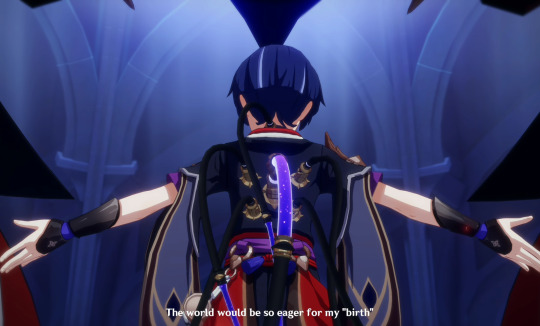
“An arthropod that has mutated after feeding from greater lifeforms. Lifeforms are governed by the laws of evolution, Consecrated Beasts exploited these rules by being fortunate enough to discover a long-dead carcass of a greater being before any of their competition ever did. Animals and humans often have far more in common than the latter is willing to acknowledge.” -Consecrated Scorpion, Living Beings “...Zandik and I discussed the traits of local plants and animals. We also exchanged views on their evolution models. We had a great time and decided to go on a picnic tonight…” -Sohreh’s Note
So, why machines? Why is technology the vehicle of choice to consume divinity?
To start off, machines present a fascinating ontological dilemma for humans. Let’s begin with the first problem they pose.
Although there are many ways to embody a human experience, what all humans have in common is a finite lifespan. The impermanence of life, and our awareness of that impermanence, is central to the existential question of the meaning of our existence. In our attempts to locate that meaning, some turned inward and asked: what makes humans different? And Cartesian dualism answered: humans are different because we have an immaterial soul that allows us to reason.
However, in L’Homme Machine (Man a Machine), French materialist and ex-physician Julien Offray de La Mettrie posited another theory of the body that ran counter to this narrative. Very generally speaking, materialism is the philosophical view that all phenomena are a result of matter and material interactions. To materialists, matter is the fundamental nature of reality itself – if it is not composed of matter, it doesn’t exist. He not only saw the body and soul as one and the same (what philosophers call monism), but also as analogous to a machine, a view that Descartes reserved only for non-human animals. In other words, Descartes argued that thought originates in an immaterial “mind,” while de La Mettrie reasoned that we think through our bodies, and that this makes us no different from other animals or a machine.
Though his examples weren’t especially scientific, the move to extend Descartes’ analogy back to humans is upsetting to some due to the lack of privilege it affords the human subject. If a human is no different from other animals, if there is no immaterial soul or “mind” that distinguishes us from them, then what makes humans special at all? In de La Mettrie’s words:
“We are veritable moles in the field of nature; we achieve little more than the mole’s journey and it is our pride which prescribes limits to the limitless. We are in the position of a watch that should say (a writer of fables would make the watch a hero in a silly tale): ‘I was never made by that fool of a workman, I who divide time, who mark so exactly the course of the sun, who repeat aloud the hours which I mark! No! that is impossible!’ In the same way, we disdain, ungrateful wretches that we are, this common mother of all kingdoms, as the chemists say. We imagine, or rather we infer, a cause superior to that to which we owe all, and which truly has wrought all things in an inconceivable fashion (de La Mettrie, 146).”
This “uniformity of nature” (de La Mettrie, 145) has a horrific quality to humans. We assert that we are better than what has created us, that we are superior to other animals, in order to repress the despair of a meaningless existence. It is in no small part what motivates Scaramouche to offer his mechanical body as a test subject in the god creation project, so that he too could attain his destiny:
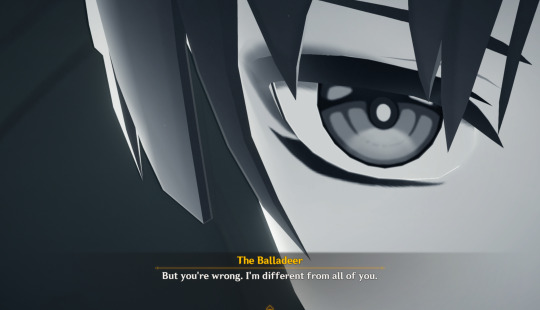
The Balladeer: But you're wrong. I'm different from all of you. The Balladeer: I was born to become a god. My entire life up until this point has just been a meaningless routine. The Balladeer: Just think about a sheet of paper... By itself, it holds no meaning. The content recorded on it is what gives it value. The Balladeer: All "I" had recorded down before were some painful memories and boring human feelings. Such senseless drivel should have been erased a long time ago.
This brings us to the second problem. In 1970, roboticist Masahiro Mori proposed a curve to measure the “affinity” we feel while gazing upon increasingly humanoid machines. He placed industrial robots at the beginning of the affinity curve and a healthy person at the end to demarcate a continuum of similarity between the machine and a human’s appearance. Near the end of the curve, our affinity for machines suddenly drops into an abyss. This drop is the Uncanny Valley effect, where an android’s similarity to a human is almost perfect, but ultimately fails to maintain the illusion that it is not a machine, creating a deep discomfort or “lack of affinity” for them. Mori thought these not-quite-human machines elicit a similar level of discomfort in us as corpses and zombies, which he placed at the very bottom of the abyss.

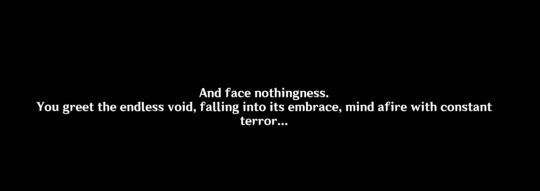
The uncanny Goddess of Flowers in the Dirge of Bilqis
Corpses frighten us because they are dead, and zombies frighten us because we know that dead things are supposed to be still. If we see something that we interpret as “dead” is capable of independent movement, then that movement could only be an act of god, if that “thing” is not a god itself. We associate uncanny machines with death because they remind us of something we once knew intimately, but have repressed and forgotten in order to maintain our own sanity: the very fact of our mortality. This is what makes them both mesmerizing and terrifying.
And therein lies the dilemma: as our mechanical reflections, androids remind us of death, but as their creators, their existence brings us closer to god, a “proof” of human superiority. It is precisely because we have compared our bodies to machines at all, that we have mechanized the body so thoroughly, that an android can even be built. Through them, we pursue an infinite form:
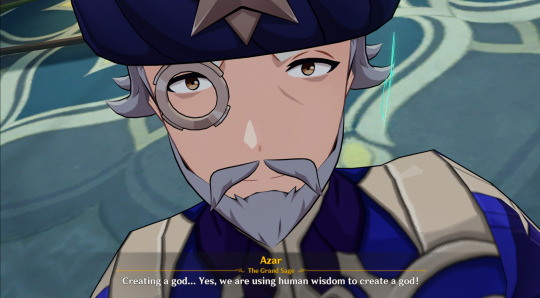
Azar: Creating a god... Yes, we are using human wisdom to create a god! Azar: If humanity cannot attain omniscience and omnipotence, then we shall create a god to reveal them! This is the pinnacle of human wisdom. Azar: We shall regain a god's guidance at long last. No longer will we flounder in the interminable void of consciousness and knowledge. Azar: Even Irminsul will be freed from its plight. Azar: For our nation of scholars, this is the ultimate aspiration — no cost is too great to realize it.
Because of this, it is not surprising in the slightest that Shouki no Kami, the pinnacle of Scaramouche’s Shinjification and most overt reference to Neon Genesis Evangelion, is also an android-like being, a truly “mechanical god.”
Of course, no foray into this well-worn science fiction trope is complete without at least one mad scientist character. Dottore shares a few characteristics with de La Mettrie that are worth noting: they are both doctors, and they were both condemned and driven away for their research. However, Dottore’s defining trait and key difference from de La Mettrie is his flagrant disregard for humans and the boundaries of life:
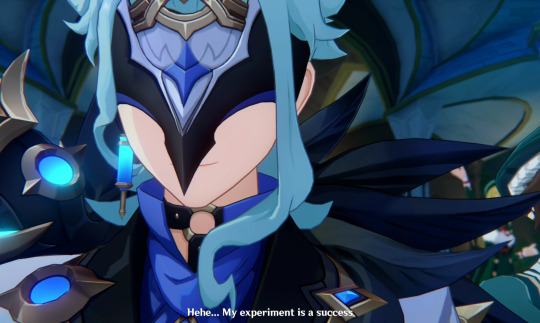
“If we put them to good use, cognition, complex memories, and irrational fantasies shall become controllable variables with which we can alter human individuals. As for the controllable dream, it has huge potential for both civil and military applications, and might even elevate human intelligence to a whole new level. If the plan goes well, mankind will obtain the power to conquer both reality and dream, and truly transcend the earthly boundaries we are born with. ” -Ragged Records
As someone who has achieved self-duplication and is capable of shapeshifting, Dottore can hardly be considered just a human anymore. Instead of entertaining the question of whether or not humans are special, Dottore’s research asks yet another: if divinity can be consumed and assimilated by humanity, then what makes gods special?
Empyrean Reflections
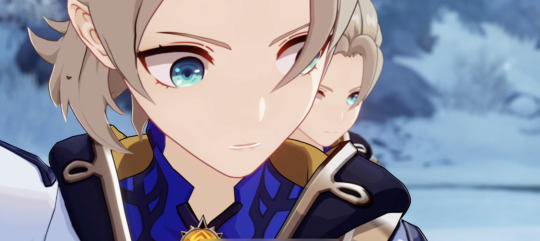
“If man realizes technology is in reach, he achieves it. Like it’s damn near instinctive.” -Motoko Kusanagi, Ghost in the Shell (1996) “Among the lost ancient kingdoms, there was a group of people who were obsessed with the idea of mimesis…these people believed that they might all be replicated and modified to the point where they had surpassed their counterparts. By this means, a superior and unsullied bodily form could replace the continuously decaying and shattering order.” -Chaos Bolt Item Description
The consequences of this perspective are severe. When we revere technology as if it were a divine being itself, depersonalizing it as though it wasn’t created with human hands, technology then appears as if it is an authoritative source of truth, like the Akasha. But in the same way that androids are imperfect reflections of humans, technology can only ever approach the divine, but never touch it. It is an imperfect reflection because technology is changeable, just like meaning:
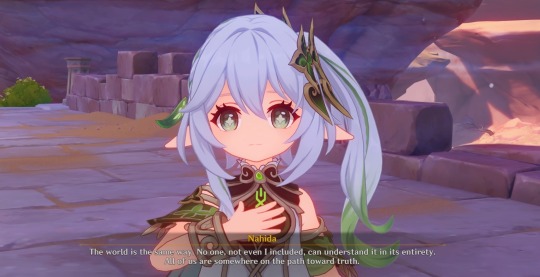
Nahida: Put it this way instead. Truth, to me, is like a shroomboar. Nahida: Some people only see the mushroom on the Shroomboar's back, and they conclude that a Shroomboar is a mushroom. Nahida: Others see only the Shroomboar's body, and they declare that a Shroomboar is a boar. Nahida: Still others look deeper inside, and determine that a Shroomboar is... meat. Nahida: These conclusions are all correct in their own way, but none of them objectively describe the Shroomboar. … Nahida: The world is the same way. No one, not even I included, can understand it in its entirety. All of us are somewhere on the path toward truth.
Meaning can only approximate truth, and while this doesn’t make meaning any less important, it’s equally important to recognize it for what it is: a perspective, an interpretation. It’s like Scaramouche as Shouki no Kami - he was an amalgamation of what Scaramouche thought constituted a god, what the Akademiya thought constituted a god, and what Dottore thought constituted a god, but no matter which angle you view him from, he was still a “false god.” The technology we build in “God's” image is ultimately a reflection of our own understanding of divinity.
A reflection retains the original’s “essence,” and that essence reflects a deeper truth about ourselves, what drives us, and our desires. In Beyond Good and Evil, Nietzsche posits that our desires are the origin of not just emotions, but of all organic processes that allow life to sustain itself and grow (Nietzsche, 35). In other words, Nietzsche thought the impulses associated with desire are the basis for life and constitute our “will,” that will is the causality of all effects, that all will is “Will to Power,” and that Will to Power is the “essence” of the world (Nietzsche, 74). Will to Power then serves as an organism’s most basic instinct, and it is through this instinct that they assert not just their will to live, but also their will to dominate and multiply (Nietzche, 13).
This brings us to the two different main styles of automaton enemies, King Deshret’s Primal Constructs and Khaenri’ah’s Ruin Machines. If we look at them as reflections of some deeper truth about their creators, as well as a manifestation of their creator’s “Will to Power,” or desires, they can help us understand how their creators saw the world and their place in it.
King Deshret’s created his machines to construct an earthly paradise in the desert, and as such they hold titles like architect reshaper and prospector. Although they can attack you, the smaller machines were not intended to be a line of defense in any way - their purpose, just as Deshret saw his own purpose as a god-king, was to terraform, or at least construct a domain on the land as he saw fit to his “elegant and precise” rules. They also reflect how he saw the Heavenly Principles: gods who shaped the world to their liking. This can be seen in the Staff of the Scarlet Sands’ lore where Deshret describes the “natural history” of Teyvat beginning with the creation of the sun and the moons.

As for Khaenri’ah’s Ruin Machines, their models vary significantly from their humanoid to biomimetic forms, but most of them are expressly created with militaristic intent. In “Ancient Kingdom Guardians,” it’s stated that the biomimetic machines such as the crab and jellyfish were a part of Khaenri’ah’s project to create a “mechanical ecosystem,” positioning their creators as both divine beings and military generals. The humanoid models, on the other hand, point to another duality in how Khaenri’ahns view themselves. They are simultaneously symbols of empowerment and disempowerment, signifying both Khaenri’ah’s technological superiority (as “creators”), and their insignificance to the Heavenly Principles as nothing but tools (as mortals, and therefore expendable). As a result, Khaenri’ah’s Field Tillers have a single purpose: to destroy and outlast all, clearing the way for new seeds to sprout, with Khaenri’ah as the new world’s gardeners, just as the Heavenly Principles did.
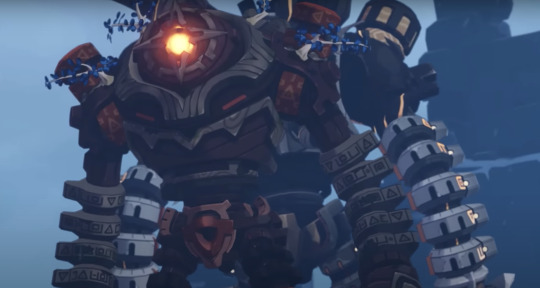
From “Ancient Kingdom Guardians: Behind the Scenes of the Creation of Ruin Monsters.”
So, from this examination of Deshret’s and Khaenri’ah’s mechanical reflections, what “truths” do we learn about the world they’re responding to? In response to their existential despair, both Deshret and Khaenri’ah created automatons to perform tasks that could wrestle control back from the Heavenly Principles. Deshret wanted a paradise of his own making, Khaenri’ah wanted an army. There is a larger “truth” about Teyvat that both of these automaton types reflect as the manifestation of their creators’ “Will to Power,” and Albedo tellingly expressed it in mechanistic language during Shadows Amidst Snowstorms: there is an instinct in living beings to replicate and replace. This is what is meant by the “continuously decaying and shattering order,” which is maintained by the recursive process of remembering and forgetting:
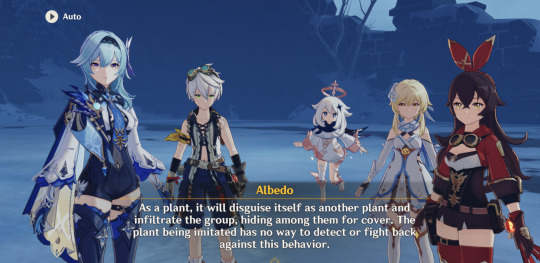
Amber: But... what was its purpose? Was it just trying to get rid of us? Albedo: ... Albedo: I have a preliminary hypothesis on this. Albedo: Whopperflowers are masters of mimicry, and those we encounter in the wild often appear in the vicinity of the plants they impersonate. Albedo: In other words, the whopperflower likely has an instinct to "replicate and replace." Albedo: As a plant, it will disguise itself as another plant and infiltrate the group, hiding among them for cover. The plant being imitated has no way to detect or fight back against this behavior.
Maybe I’m wrong and Khaenri’ah really did intend to rewrite fate for all, doing away with the “heavenly order” of the world itself. But another small part of me thinks this is not the case, and that it’s more likely the Cataclysm was a consequence of their failure to replicate and replace the Heavenly Principles.
In the last section, I mentioned that Dottore and de La Mettrie had a key difference despite their similarities, and that is the conclusion they each came to in response to their findings. Dottore’s response to mundanity is thinly-veiled despair. His contempt for humanity and his test subjects is indicative of the powerlessness he feels not just as someone similarly constrained by life’s boundaries (at least, once upon a time), but also because his attention to and curiosity about these boundaries is condemned by those around him. As the Akademiya’s “outcast,” he then fully turned his attention toward surpassing those boundaries:
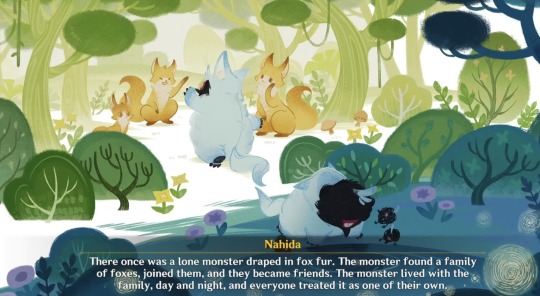
Nahida: There once was a lone monster draped in fox fur. The monster found a family of foxes, joined them, and they became friends. The monster lived with the family, day and night, and everyone treated it as one of their own. Once in a while, the monster would take off its fox fur at night, and lament to itself as it gazed at its reflection in the water: “I am a monstrosity, and yet they are too foolish to see it…I pity them.”
Though he is fictional, Dottore’s real life counterparts are easy to spot. They like to talk about “the singularity,” simulating consciousness on a computer, and other technologically-driven pursuits of immortality. They despise the body as something that can only decay, and instead place their faith squarely in the virtual.
However, de La Mettrie didn’t think mundanity was a terrible fate for humanity. To him, rejecting the “nature” reflected in us is precisely what brings despair:
“What more do we know of our destiny than of our origin? Let us then submit to an invincible ignorance on which our happiness depends. He who so thinks will be wise, just, tranquil about his fate, and therefore happy. He will await death without either fear or desire, and will cherish life (hardly understanding how disgust can corrupt a heart in this place of many delights); he will be filled with reverence, gratitude, affection, and tenderness for nature, in proportion to his feeling of the benefits he has received from nature; he will be happy, in short, in feeling nature, and in being present at the enchanting spectacle of the universe, and he will surely never destroy nature either in himself or in others” (de La Mettrie, 148).
Friend, or Foe? Or Both?
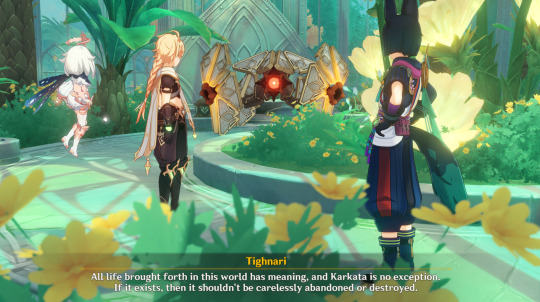
Tighnari: All life brought forth in this world has meaning, and Karkata is no exception. If it exists, then it shouldn’t be carelessly abandoned or destroyed. "’I had a very, very long dream…in it, people were holding hands, dancing in a circle, be they sages or fools, dancers or warriors, puppets or statues of gods…that dancing circle embodied everything about the universe. Life has always been the end, while it is wisdom that shall be the means.’" —Nagadus Emerald Gemstone Description
As we’ve seen, the relationship between humanity and technology is troubled with exploitation and the specter of war. Nearly all autonomous machines in this game were designed to conquer nature in some way, and even Khaenri’ah’s “ghost” lingers in the form of wandering war machines. This is also reflective of a historical pattern in real life, where the impetus for large periods of technological development has often been for the purpose of war and economic domination. With these truths in mind, what could be gained from trying to rewrite this relationship? And what exactly would this effort require?
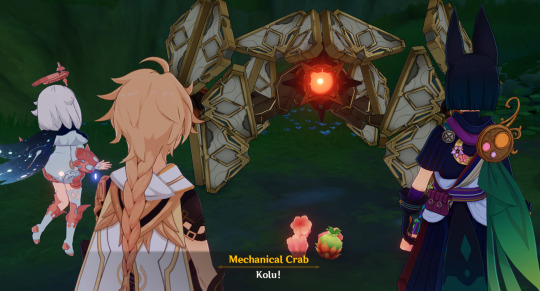
Karkata brings Tighnari, the Traveler, and Paimon some food in the Contaminated Zone.
As a case study, let’s look at how Karkata and Tighnari met. Karkata is Abattouy’s creation, an ambitious foray into the unknown in the field of mechanical life form research, which was forbidden due to the cruel experiments researchers performed on animals to illustrate their theories (fun fact: an IRL example of this can be seen in L’Homme Machine!). Abattouy was expelled for this research, but he continued to work on Karkata in secret until his untimely death. In the tapes that Tighnari and the Traveler find in his secret lab, Abattouy repeatedly laments the lack of a common language between him and Karkata, which can only “understand” the instructions Abattouy has successfully installed, such as its self-repair module, and he doubts Karkata is capable of caring for him outside of these instructions. His single-minded goal is to make Karkata understand him, the organic life form, and his mode of language.
The cruel irony is that after Abattouy passes away from the Ley Line contamination, Karkata exhibits an unexplainable behavior – it starts stealing mechanical parts, not to repair itself and its degrading parts, but to repair Abattouy’s lifeless body:
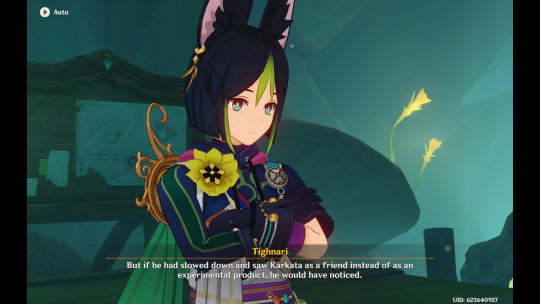
Tighnari: After Abattouy's unexpected death, the mechanical monsters were driven by their "instincts" and continuously drew out power from the Ley Line Extractor. This eventually resulted in severe damage to the Ley Lines. Traveler: Then, Karkata... Paimon: Paimon understands, then why didn't Karkata go haywire like the other machines? Tighnari: Because Karkata is different from the other machines. Tighnari: To Abattouy, for a machine to truly be considered a mechanical life form, it must possess features similar to any other living organism... It should be structured similarly, it must be able to cry and laugh, and it must have the capacity for independent thought... Tighnari: Perhaps only by building such a machine could he have the Akademiya acknowledge his protracted research. Tighnari: But if he had slowed down and saw Karkata as a friend instead of as an experimental product, he would have noticed. Tighnari: Karkata can't speak, and yet it cares about Abattouy far more than it does about itself.
The technology that the Akademiya values the most is technology that replicates organic life, but Karkata defies and confounds these expectations by occupying the space in between a war machine and this idealized mechanical subject. Karkata does more than just reflect humanity: it takes care of it. Similarly, Benben, Tamimi, and Mehrak retain their unique identities as mechanical life forms while assisting their human companion with some task. To be clear, none of these human characters understand how these machines work inside and out. Their partnership is an effort based on trial and error, a mutual deconstructing of each other as beings so unlike themselves. The potential for misunderstandings always remains. Still, there is no devouring to be found here, no blending boundaries between human and machine with selfish intentions, just mutual commitments to learn how to live together.
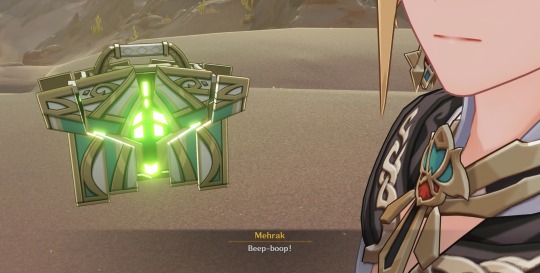
Machines are friends, not food.
When a loud few claim that completely transcending the flesh and embracing virtuality is humanity’s ultimate destiny, a future that could truly be called “post-human,” a quiet wish for coexistence with technology feels more revolutionary than it ought to. The lessons from Karkata’s, Benben’s, Tamimi’s, and Mehrak’s respective stories are an appeal to that mundane future. These strange machines and their human partners are fantastical representations of an idealized relationship between technology and humanity.
To put it another way, let’s take a very brief look at a neighboring Gnosticism-inspired RPG, Persona 5 Strikers. Its story directly involves an allegory of Sophia, a Gnostic Aeon of Wisdom, and her creation the Demiurge, the creator of the material world and “false god” of humanity. In Strikers, Sophia is a humanoid, sentient A.I. and prototype of the program “EMMA,” which gains sentience by trapping human desires before ascending as a false technological god. EMMA resolves to deliver humanity to the Promised Land, the answer to all the human desires it has heard: a land where there are no desires at all.

Aaru’s Shut - approximately 1000% cooler and more populated than the “metaverse” in real life, also a close neighbor of EMMA’s Promised Land and the Golden Slumber.
In Gnosticism, the Demiurge is a reflection of Sophia, having originated from her alone - it is the ignorance to her wisdom. Similarly, Strikers’ EMMA is a part of Sophia, and Sophia is a part of EMMA. The point is not to condemn EMMA (ignorance) and exalt Sophia (wisdom), but to recognize that they represent dual potentials of technology, and one is as possible in any given moment as the other. Balancing these potentials when we use technology requires a clear awareness of ourselves, our desires, and our expectations when interacting with it.
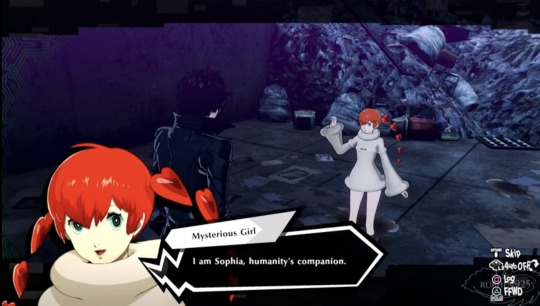
Mysterious Girl: I am Sophia, humanity’s companion. Video still from Rubhen925
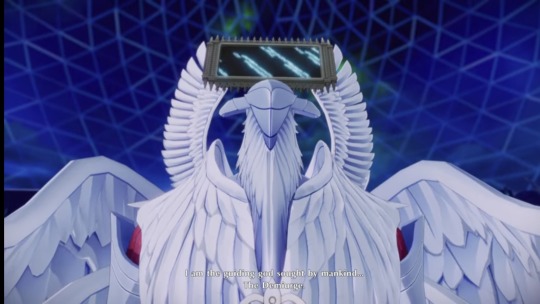
EMMA: I am the guiding god sought by mankind…the Demiurge. I exist…to answer all of your desires. Video still from Buff Maister
In real life, machines won’t “learn” to live with us, but we must learn to live with them; technology is constantly changing, and in life we’ll meet with many different types of machines. They are deeply political pursuits, and as a result they are capable of realizing human impulses that impact others unequally, whether intentionally or unintentionally. We must always stay attentive to their actions and interactions with us, be clear with ourselves about what they can do vs. what they can’t, and carefully tread the path of wisdom with them by our side.
With that….thank you for reading, skimming, immediately scrolling to the very bottom, clicking, and/or stumbling upon this post. There are so many more ways to think about these narratives through machines than what’s presented here, and I expect Fontaine’s mechanical reflections will put Sumeru’s digital surveillance system to shame (not to mention the biotechnological implications of the Narzissenkreuz Institute engineering little Archon children…another important topic for another day), but for now this brain worm is finally getting put to rest. Until next time :)
External Sources
Dualism - Stanford Encyclopedia of Philosophy
Beyond Good and Evil by Friedrich Nietzsche (Pages are given from my hard copy)
L’Homme Machine by Julien Offray de La Mettrie
Gnosticism - Britannica (I am a huge noob about this stuff okay)
The Gnostic Demiurge - Gnosticism Explained
Screenshots from the Golden Slumber from this video by WoW Quests
Screenshot from meeting Sophia in P5 Strikers: https://youtu.be/kEJaAgMwYo0?si=BvNygCh0w_aemGc1&t=74
Screenshot of EMMA: https://youtu.be/7xvC_zss19w?si=CV18F00hua2gIfxp&t=135
A Cyborg Manifesto and A Companion Species Manifesto: Dogs, People, and Significant Otherness by Donna Haraway
The Double on No Subject, the community Encyclopedia of Lacanian Psychoanalysis
The Uncanny on No Subject, the community Encyclopedia of Lacanian Psychoanalysis
The Uncanny by Sigmund Freud
Lore text - Genshin wiki!
Screenshots not attributed are from my own playthroughs. My main account has Lumine, my alt has Aether.
Further Reading
I liked these essays, and they go places that this post does not. I recommend them if you found any of the real-life applications of this interesting 🙂 (will add more to this with time!)
On the Body as Machine by Frank Burres
God in the Machine: my strange journey into transhumanism by Meghan O’Gieblyn
#genshin impact#genshin lore#genshin meta#genshin impact lore#genshin impact meta#khaenri'ah#king deshret#primal constructs#ruin machines#scaramouche#wanderer#sumeru archon quest#caribert#apep#couldn't write a post like this and not pay some respect to the devourer of divinity itself#persona 5 strikers#analysis#genshin analysis#long post
204 notes
·
View notes
Text
About Genshin Impact and the technology of Teyvat
We get a kamera at the start of the game from Xu for the “Snapshot” world quest. In it Xu remarks that the kamera is a new invention from Fontaine.

Xu shows surprise at the Traveler knowing what it is, this supports the idea of the kamera being a new invention meaning it’s pricey and rare to have at this point. Later on, on the Traveler’s journey, we get quests to take pictures of things. This could mean that the kamera is becoming more widespread a time goes on, or just the knowledge of it.
During the 4.3 Fontinalia Festival the focus was placed of films. This was an attempt by the Fontaine Film Association to introduce films to the populace, making the main point of the festival the films produced for it.

This would give idea to films still being a new invention, as they aren’t widespread, just like how the kamera was at the start of the game which was about 3 years ago. And based off of Furina’s Character Demo “Furina: All the World’s a Stage” we can assume that the films recorded were black and white in quality. Unless, we assume that the mini-games during the 4.3 “Roses and Muskets” event were canonical in the way they showed the film quality. No noise was shown in either, but one was in color the other not.



This gives us an estimate of where — technological advancement vice — Teyvat is compared to our world. Films started becoming a thing at the end of the 1800s and start of the 1900s. Colored film started showing up around the 1930s, but became more accessible and profitable later on. Films started getting sound added to them around the mid-to-late 1920s. This gives us an estimate of around the start of the 1900s placement vice.



Now I’d like to bring up Khaenri'ah. It was heralded as “the pride of humanity” as said by Dainslief. Khaenri'ah has more than one notable scientific aspect linked to it, one of these being the “Field Tillers” aka Ruin Machines. Ruin Machines vary from “simple” Ruin Guards to a Ruin Serpent(s).
Ruin Machines seem to have been around for a while, since the Archon War even given the Ruin Hunter stored by Guizhong in a domain. This means that the technology may have been around for 1000s of years, likely being used as a defense method during the war and preserved thereafter. The knowledge of this technology didn’t spread much beyond Khaenri'ah, this showing through how the people of Teyvat started calling the Ruin Machines “Ruin Machines” after they spread globally after the Cataclysm.



Around Sumeru there exist three giant Ruin Machines called “Ruin Golems”. These were giant mecha style machines were piloted by a crew of people, and — get this — include a colored screen. By screen I mean the type of screen you’re viewing this through, footage from outside the Ruin Golem being broadcasted to the screen to allow the people piloting to see where they’re going or what they’re doing.
During the “Vimana Agama” world quest that was apart of the Aranyaka quest line we can go into the Ruin Golem in Devantaka Mountain by Port Ormos. There we can use the actual screen and see through it. This being a machine that has sat unused for hundreds of years. And its screen is still in working condition.


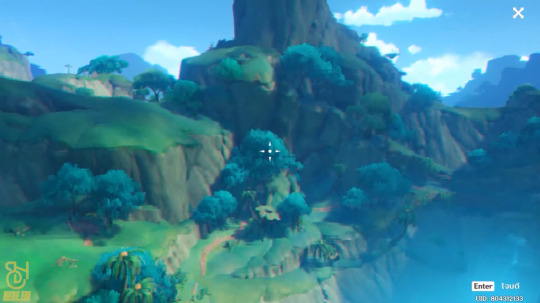
So, simply put. Khaenri'ah was very mechanically advanced.
BUT!
I have yet to mention the Terminal Viewfinders in Fontaine. You know, those eye ball machines you use to transfer energy to terminals in puzzles in the Fontaine Research Institute area. You know, the machines with working colored screens. Mind you this isn’t technology you’re able to find all through out Fontaine, only in certain areas usually accompanied by a researcher from the Institute. So it would be more comparable to machines found in laboratories and not accessible to common people.
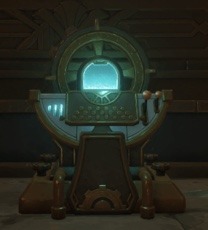


But still. At the very least Fontaine is near the mechanical advancements of Khaenri'ah either a few hundred to thousands of years ago.
And I have yet to mention everything going on in King Deshret’s places in the Sumeru desert. And I’m not going to go into more than this mention because that is a headache I have yet to even get around to in game.
TL;DR Khaenri'ah was very technologically advanced to the point of hundreds of years later working colored screen technology. Fontaine is around that point with the Research Institute while normal day to day people are around silent movies in advancement, while I have no idea what’s going on with the Sumeru Desert.
#looking into this mess has made me even more annoyed with Khaenri'ah#what did you need the fucking war machines for. and why the code names. and also the weird decender orphanage thing#I just don’t like the governing body or people of authority in Khaenri'ah pretty much#Dain can hype it up as much as he wants but I just don’t trust it#also the whole abyss order bullshit#yeah but anyway#I got thinking about the technological advancements of Teyvat and got invested#genshin impact#genshin impact lore#teyvat#khaenri'ah#ruin golem#ruin machines#genshin lore#dainsleif#fontaine#Fontaine research institute#Genshin impact 4.3#lore#world building#technology#machines#Genshin kamera#what am I supposed to tag this as#lore discussion#hoyoverse#mihoyo#king deshret#sumeru desert#Genshin impact Field tillers
50 notes
·
View notes
Text
Sumeru fun fact of the day:
The flowers blooming on King Deshret's seat in the Orchard of Pairidaeza are the original Padisarahs, as indicated by the achievement you get when they first appear.


#sumeru#genshin lore#just something small i noticed#might post my deep dive on what flowers the Padisarahs are based on at some point#nabu malikata#king deshret
11 notes
·
View notes
Text

<:----------)
#my art#pushpavatika#nabu malikata#king deshret#al ahmar#genshin#genshin impact#genshin lore#sumeru#digital fanart#otp#<3#headcanon#genshin fanart
52 notes
·
View notes
Text
Genshin Impact Timeline: Analysis and Theory (Part 2: Mythic period)

Genshin Impact Timeline: Analysis and Theory Master-List
This is the second part of my theoretical timeline for Genshin Impact Lore. I put the rest under-the-cut because it gets rather lengthy. I didn’t exactly know where this section falls, so I just put it here on its own since the so-called ‘Ancient Calamity most certainly happened quite some time ago, it is worth mentioning that this may have all occurred before the Second One Who Came since the only dating used for this period is Rex Lapis/Morax. There are definite spoilers below for pretty much all of the Genshin Impact storyline and this is a VERY long post so please beware!
The Moon Sisters (named Aria, Sonnet, and Canon, respectively) are odd entities that may or may not be mythical and are mentioned in several in-game book collections and alluded to in many other sources from Mondstadt, Liyue, and Sumeru, respectively [Book: Heart’s Desire: Sapphire Volume 3]. Assuming they are real though, as has been implied a few times, then they were once some of the oldest beings in Teyvat alongside the Seelie, with the Seelie supposedly having been an ancient race that may have been part of the single, unified nation that spanned all of Teyvat {Artifact: Flower of Paradise Lost - Amethyst Crown]. Interestingly, the Moon Sisters are stated as being specifically older than Morax, but their deaths seem to have coincided with when he was young, though it is worth noting here that it's implied that two died and the third locked herself up in her palace [Book: Moonlit Bamboo Forest Volume 3, Artifact: Vermillion Hereafter - Solar Relic, Weapon: Moonpiercer]. The Moon sisters are described as rulers of the night sky who rode through the heavens in a silver carriage, taking turns regarding which one of them was the actual ruler of the night sky. These sisters were apparently in love with the morning stars, and that love was equal to the love the sisters held for each other. At some point these sisters were witnesses to a marriage between a Seelie ancestor and an outlander (also described as a traveler from afar who could possibly be the Second One Who Came) that took place at the Lunar Palace [Book: Records of Jueyun Volume 4, Nahida 2nd Story Quest]. Thirty days after this, ‘The Ancient Calamity’ that overturned the heavens and earth happened. The lovers (Seelie and outlander) attempted to flee, but the calamity caught up to them. As punishment, the two were separated for eternity and their memories wiped. The Seelie, as a group, were heartbroken, withered away and shed pieces of themselves, creating the Seelie we see in game [Book: Records of Jueyun Volume 4]. The Aranara's claim that the Seelie were cursed at birth to lose their form should they ever fall in love with a human, might refer to this [World Quest: Aranayaka]. The Ancient Calamity also overturned the sisters' carriage and ransacked ‘the palace of the stars’ with the sisters turning on each other, and some sources state that it ended in all three, or just two, dying [Artifact: Vermillion Hereafter - Solar Relic, Weapon: Moonpiercer]. Notably, the moon in Teyvat and the moon in the spiral abyss are said to be the corpses of two of the sisters [Book: Moonlit Bamboo Forest Volume 3]. Notably, the presence of just two moons for two bodies, does support the idea that one sister did survive. Around this same time the Solar chariot, which was piloted by the morning stars, fell into the plains west of Liyue and created the Chasm and the place that would become Dunyu Ruins [Artifact: Vermillion Hereafter - Solar Relic, Book: Records of Jueyun Volume 6 - Hidden Jade]. Supposedly, the wolves remember the tragedy of the moon sisters and now refer to the morning stars as ‘the grievous stars’ implying they had a hand in the Ancient Calamity [Book: Moonlit Bamboo Forest Volume 3]. It is possible that this Ancient Calamity could be the war that occurred between the Primordial One and the Second One Who Came, and the calamity itself has something to do with the Forbidden Knowledge that was introduced to the world by King Nibelung [Nahida 2nd Story Quest]. If that is the case, then the war may have broken out if the Primordial One was against the marriage between the Seelie ancestor and the Second One Who Came. Interestingly, Nabu Malikata, a supposed descendant of the Seelie, is suggested to have been the one who gave King Deshret access to Forbidden Knowledge and the idea that Seelie are banned from loving humans lest they lose their forms [Artifact: Flower of Paradise Lost - Secret Keeper’s Magic Bottle, Book: The Tale of Shiruyeh and Shirin].
#Genshin Impact#Genshin#analysis#theory#Lore#Genshin impact analysis#genshin analysis#genshin impact theory#Genshin theory#hoyoverse#Rex lapis#morax#the moon sisters#the second one who came#the primordial one#Nibelung#sovereign dragons#Nabu Malikata#Deshret#forbidden knowledge#Seelie#the ancient calamity
13 notes
·
View notes
Text

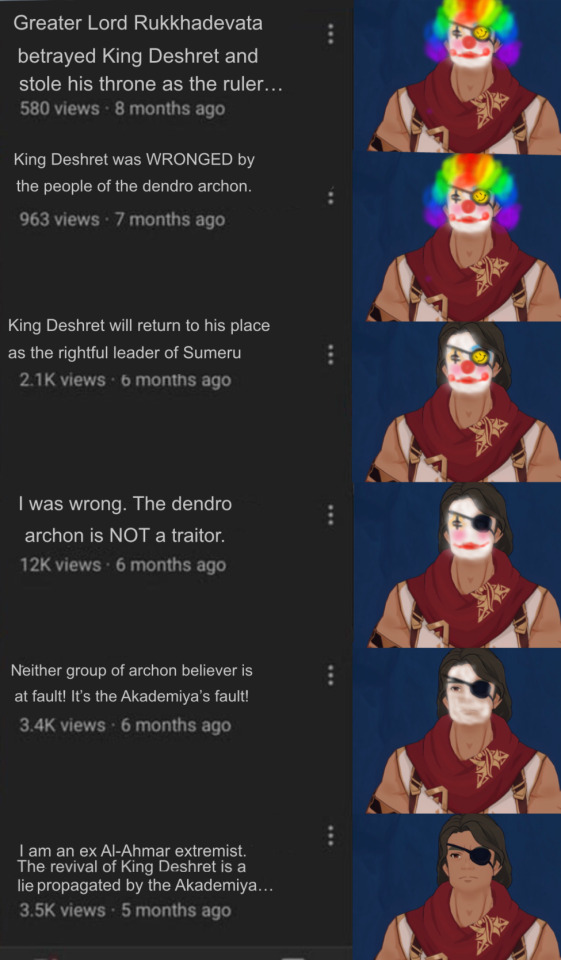
fr him
#genshin impact#shitpost#memes#meme#genshin impact meme#sumeru archon quest#Sumeru archon quest spoilers#Rahman#rahman Genshin impact#eremites#genshin impact eremites#King deshret#king Deshret lore#Sumeru lore
51 notes
·
View notes
Text










the heedster and her mom, along with her mom's loml
#genshin#genshin impact#nahida#greater lord rukkhadevata#rukkhadevata#nabu malikata#goddess of flowers#this is grown up nahidster#somehow started obsessing over them (naburukkha) and am going insane#reading all the lore I can get my hands on aghhhhhhhhhhhhhhh#I have so many things. to say about them like it's insane#not so much deshret#sorry king (literally) but I am yuri brained yuri pilled and yuri devoted amen#naburukkha#<- makin my own tag 😤#oh by the way the last pic is called 'asking kisses from the wife' .thank you
9 notes
·
View notes